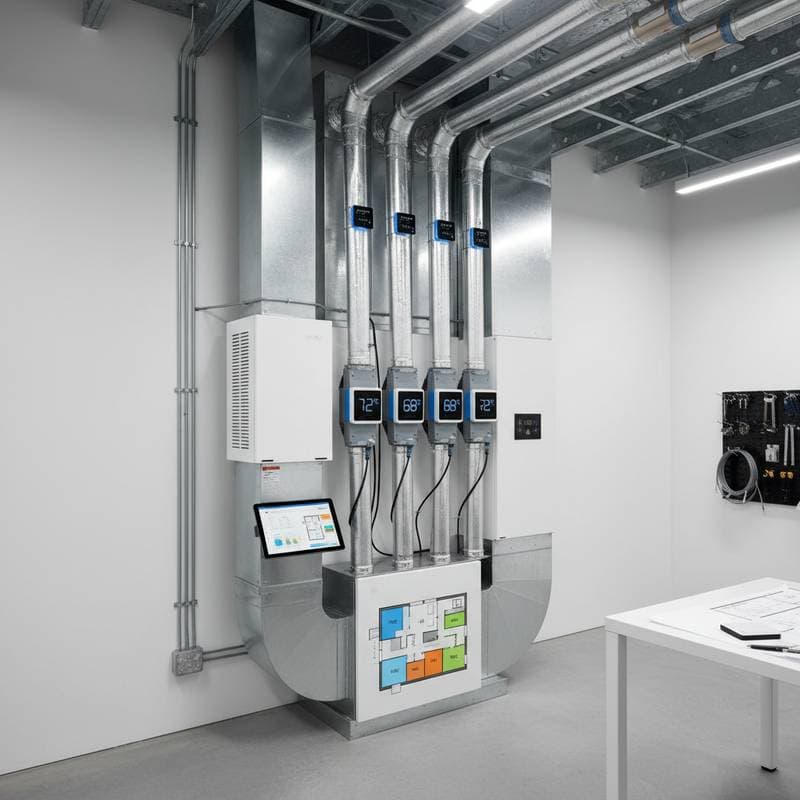Smart Humidity Control Reduces Mold Claims by 58 Percent
Smart humidity control stands out as a proven method to halt mold growth in residential settings. Data from recent studies indicates that homes equipped with comprehensive humidity management systems experience a 58 percent drop in mold-related insurance claims. This direct link between precise humidity regulation and mold prevention elevates advanced dehumidifiers and integrated controls to essential components of modern, healthy living environments.
This resource details the critical influence of humidity on mold formation, the mechanics of smart whole-home dehumidifiers, and practical measures to shield your property from mold, compromised air quality, and expensive repairs.
Quick Answer Box
| Item | Key Insight |
|---|---|
| Mold Claim Reduction | 58 percent fewer insurance claims through smart humidity management |
| Ideal Indoor Humidity | 40 to 50 percent relative humidity |
| Typical Whole-Home Dehumidifier Cost | $1,200 to $2,800 for installation |
| Energy Savings | Up to 15 percent reduction in cooling expenses |
| Average Lifespan | 8 to 12 years with routine maintenance |
Factors Influencing the Cost of Humidity Control Systems
Multiple elements determine the expense of installing a whole-home dehumidifier or smart humidity solution. A clear grasp of these variables aids in precise budgeting and selecting an appropriate system.
Home Size and Layout
Homes with greater square footage demand dehumidifiers of increased capacity. For instance, a compact single-story residence may suffice with a 70-pint-per-day model, whereas a sprawling multi-story property often requires 100 pints or higher. The intricacy of ductwork further impacts installation duration and overall pricing.
System Type and Features
Units featuring embedded sensors and Wi-Fi integration command higher prices compared to standard manual models. These advanced options provide continuous humidity tracking and self-regulating adjustments, averting water damage with minimal homeowner intervention.
Energy Efficiency
Models certified with superior Energy Star ratings consume less power. Although the upfront cost rises, these efficient systems lower ongoing electricity bills and sustain steady humidity amid varying climatic conditions.
Installation Complexity
Properties with pre-existing HVAC infrastructure that supports duct integration simplify retrofitting. In contrast, older structures or those lacking central air conditioning may necessitate extra ductwork or electrical modifications, which elevate labor charges.
Brand and Warranty
Reputable manufacturers typically offer extended warranties and durable parts. Such investments, while increasing initial outlay, promote dependable operation and minimize the need for frequent repairs.
Indicators of Inadequate Humidity Management
Recognizing signals that your residence requires enhanced humidity oversight proves vital for averting mold and structural deterioration. Consider these prevalent symptoms:
- Lingering musty or moist smells
- Moisture buildup on windows or walls
- Flaking paint or blistering wallpaper
- Distorted wooden floors or furnishings
- Recurring allergic reactions or breathing difficulties
- Apparent mold patches in corners or adjacent to vents
- Hygrometer measurements exceeding 55 percent
The presence of two or more of these signs suggests elevated humidity. Prompt action mitigates the risk of substantial future expenses.
Steps in Installing Whole-Home Dehumidifiers
Expert installation guarantees accurate sizing, seamless integration, and peak functionality. The procedure unfolds as follows:
-
Home Assessment and Capacity Determination
Technicians evaluate the property to calculate dehumidifier needs, factoring in area, insulation quality, and current HVAC configuration. -
Model Recommendation
Drawing from the assessment, professionals suggest a unit aligned with humidity targets and efficiency standards. -
Positioning and Duct Connection
The device installs proximate to the furnace or air handler, linking to the return duct for air circulation through the dehumidifier prior to conditioning. -
Moisture Drainage Configuration
A dedicated line routes extracted water to a sump pump or drain, avoiding accumulation. -
Power and Control Integration
Wiring connects to HVAC controls or a specialized thermostat. Smart variants undergo Wi-Fi linking and application configuration. -
Performance Verification and Adjustment
Specialists measure humidity, confirm airflow, and fine-tune parameters for maximum effectiveness.
Common Questions on Smart Humidity and Mold Mitigation
In What Way Does Smart Humidity Control Diminish Mold Claims?
These systems autonomously sustain humidity within healthful parameters. By restricting moisture below levels conducive to mold proliferation, they curtail incidents of growth and property harm, thereby lowering insurance filings.
What Humidity Level Best Deters Mold?
Aim for 40 to 50 percent indoor relative humidity. Levels surpassing 60 percent foster mold, whereas those under 30 percent can desiccate materials and irritate airways.
Does a Portable Dehumidifier Suffice for an Entire Home?
Portable devices manage isolated areas effectively but fail to uniformize humidity across expansive or multi-level layouts. Whole-home installations deliver consistent coverage without manual relocation or reservoir maintenance.
Must Smart Systems Rely on Wi-Fi?
Basic operations proceed without internet, yet Wi-Fi unlocks remote oversight, timed cycles, and diagnostic notifications.
What Maintenance Schedule Applies to Dehumidifiers?
Inspect filters bimonthly and arrange yearly professional reviews. Such diligence preserves efficiency and prolongs service life.
Can Dehumidifiers Decrease Cooling Expenses?
Indeed, as reduced humidity enhances perceived coolness, air conditioners cycle less frequently. Users often achieve 15 percent savings in cooling costs post-installation.
Does Investing in Smart Humidity Pay Off?
Yes, through avoidance of mold cleanup fees, allergen control, comfort elevation, and structural preservation. Cumulative advantages surpass the original expenditure.
Sustaining System Performance
Post-installation, diligent upkeep secures enduring dependability. Routinely clean or swap filters, clear drain paths of obstructions, and dust the unit's vicinity. Leverage app or thermostat displays to track levels and adapt to weather shifts.
Annual checkups by qualified HVAC experts identify minor faults early, forestalling major overhauls. These sessions confirm the integrity of sensors, connections, and outflow mechanisms.
Equilibrium in humidity extends beyond surface protection; it cultivates a salubrious atmosphere, optimizes HVAC operations, and upholds your home's value. Solicit bids from credentialed specialists to secure competitive rates and proficient setup for your humidity solution.





